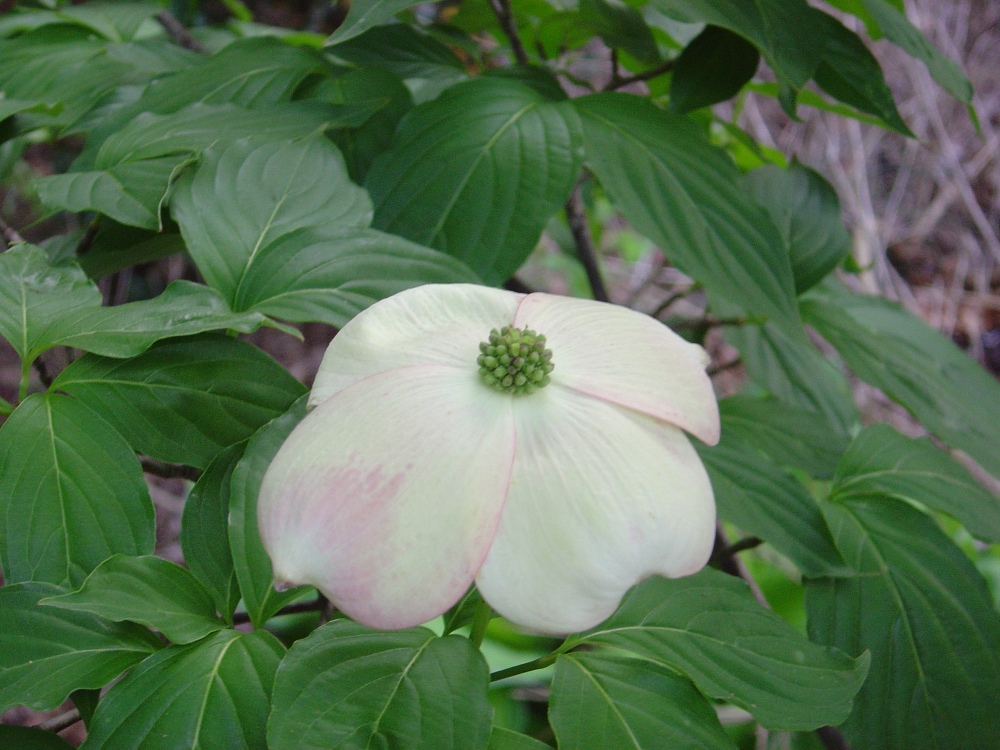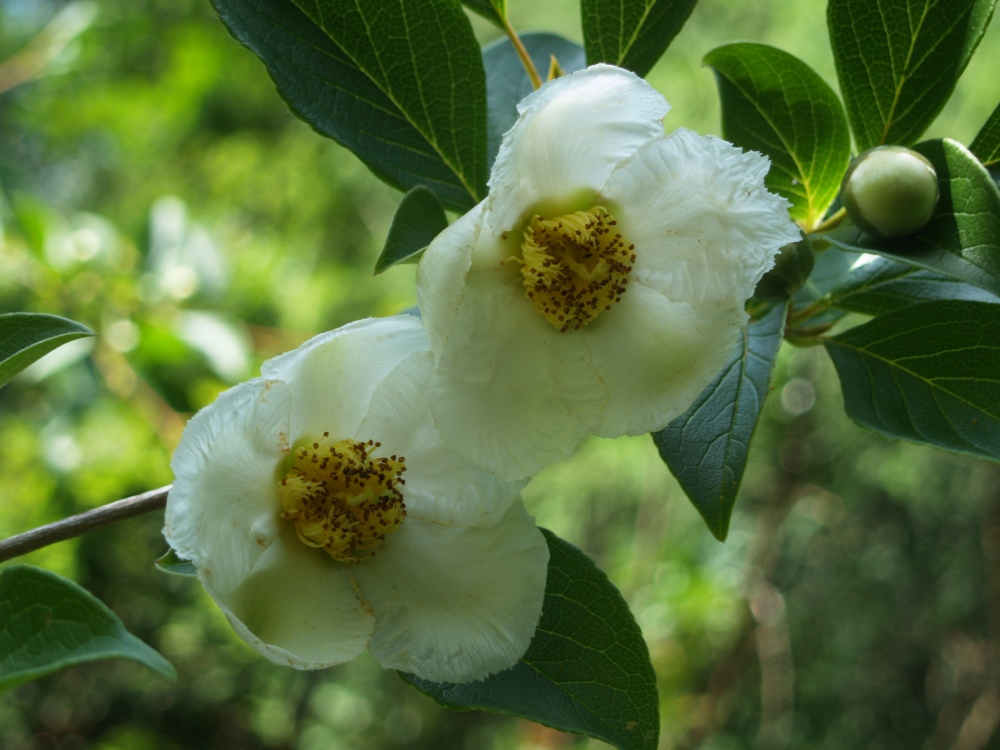I suspect that many gardeners are hopeless collectors of plants. Recently, I wrote about the collection of Japanese maples (Acer palmatum) in the garden, and the many irises, but there are more. Possibly, too many.
There are a dozen or more dogwoods of various stripes in the garden. The native Eastern dogwood (Cornus florida) begins to flower by mid April in most years. Now, in mid June the flowers of Chinese dogwoods (Cornus kousa) have faded, except a scattered few on ‘Satomi’ (above), that begins and ends a bit later. By planting one native, a hybrid (such as ‘Stellar Pink’), and a Chinese dogwood the gardener is assured of six weeks of continuous dogwood blooms, and occasionally two full months. Planting four or five (or fifteen) is not a necessity, though there are many splendid choices with varying flower and foliage colors for a more spacious garden.
The Eastern native is the most difficult of the dogwoods, but there are several in this garden that have thrived for twenty-five years. I expect they will survive for as long as I do, though they are regularly plagued by minor traumas in the heat of summer.
Sweetbay magnolia (Magnolia virginiana, above) is the least conspicuous of the magnolias in the garden. It is planted along the forest’s edge, and its shrubby habit blends with the neighboring foliage. This is, of course, its native habitat, where it is obvious when flowering, and occasionally when its silver backed leaves flutter in a breeze. The flowers of Sweetbay magnolia are smaller and less abundant than on other magnolias, but they are sweetly scented.
In this dry shade, Sweetbay is a treasure. While it will tolerant damp soils, it shows no significant decline when the soil is baked hard and dry. Recent introductions are nearly evergreen, but this Sweetbay magnolia drops most if its leaves, whether the winter is cold or mild.
I’m thankful that I did not go whole hog to plant more than a single Golden Rain tree (Koelreuteria paniculata, above) when the garden was young. Many gardeners seem enthralled by this yellow flowered tree, but its brittle branches and prolific seedlings soured my enthusiasm for the tree long ago. I would not be terribly disappointed if a summer storm shattered what remains of the the Golden Rain (which is, unfortunately, most of it, though storms have broken several large branches). I suppose the tree could be managed if planted with only sod beneath it, but its thousands of seeds spread through too much of the garden, and create far too much work for the gardener.
I have long considered planting a Mountain stewartia (Stewartia ovata), but have been unable to find a tree of adequate size to satisfy my impatience. Certainly, I waited long enough for a thin, six foot Stewartia pseudocamellia (above) to grow to make a show. Perhaps it is slightly quicker to get started than the purple leafed European beech (Fagus sylvatica) that hardly grew an inch for eight years (though now it is a magnificent fifty or sixty feet tall). While the stewartia is hemmed in by Japanese maples and dogwoods that towered over the young tree, today it rises above its neighbors.
Remarkably, there are as many flower buds on shaded lower branches as ones popping into the sun. These open to flower over several weeks in June, and then I wish that it was planted front and center in the garden so neighbors could enjoy it also. But, this would move a dogwood or two to a less prominent spot, so I quite satisfied with the way things are.
“I suspect that many gardeners are hopeless collectors of plants. ”
Yeah, that sort of describes me! I’m always trying to cram too many plants into too little space. My wife tends to do the same, so we sometimes have conflicts over what should be planted where.
I, too, love dogwoods, especially the new Akatsuki dogwood, which I consider the perfect tree for a small yard. It’s extremely attractive. But of the few nurseries that carry it, almost all are sold out (I now want a second Akatsuki).
Yes, I too find the Japanese Stewartia trees very attractive, and planted one about 7 years ago. Their bark is appealing and they flower in June, when few other trees flower. BUT… they sure are slow growers! They definitely aren’t common, as I think I am the only one in our development who owns one.
I don’t recall how long ago I planted the stewartia, but after four or five years it began to grow. I’m not so good at keeping track of these things, but it seems like it jumped from seven feet to fifteen feet tall overnight. Since it is slow to get started tree growers are reluctant to grow stewartia, so an extra year or two to grow a small tree and limited supply results in a tree that is expensive to the gardener. To the average homeowner who is not an addict, dogwoods and redbuds are a much better value, so your tree and mine will probably always be the only ones in the neighborhood.
Up here (Boston area) Japanese Stewartias can be found at the larger garden centers and occasionally planted in yards, though of course far, far less often than dogwoods, magnolias, or Bloodgood Japanese maples. Most also seem to be recently planted and to see some truly mature, magnificent specimens one has to visit the Arnold Arboretum.
My own Stewartia was planted just last spring, only about 5 feet tall. It actually grew nearly a foot last year — so quickly that I was worried it wasn’t growing roots — but it survived a tough winter without problem and has already put on nearly another foot this year. Go figure.
Dave, there is one tree you have not mentioned yet (as best I can recall) that seems to be a favorite with many plantspeople, namely the paperbark maple (Acer griseum). Have you ever tried one?
There are so many environmental variables that determine growth rates that I hesitate to make pronouncements. With a foot of growth on a small tree yours is evidently planted in an ideal circumstance, and I suspect that if a stewartia is container grown it might take off a bit more quickly.
In fact, I do have a paperbark maple at the rear corner of the garden, but it has been overgrown by two huge bald cypresses on the neighbor’s property and a particularly vigorous river birch on mine. The poor tree only gets sun during the winter, and I think this does it little good. It’s still alive, but living in the dark it doesn’t amount to much. There are a bunch of other trees in the garden that I barely mention in these pages. A large green weeping beech is exceptional, but few people seem to care about these anymore. There are katsuras, parrotia, catalpa, weeping hornbeam and bald cypress, and several large evergreens that I treasure, but only diehards appreciate.
I don’t recall seeing any parrotias around here, not sure why. A mature one I saw in England a few years back was massive (wider than tall) and gorgeous. Would love to see some photos of yours, particularly in the fall.
Unfortunately, mine is too shaded to get the full effect in autumn. I’ve considered taking out lower branches of nearby maples. Someday I’ll work up the energy to take this on.